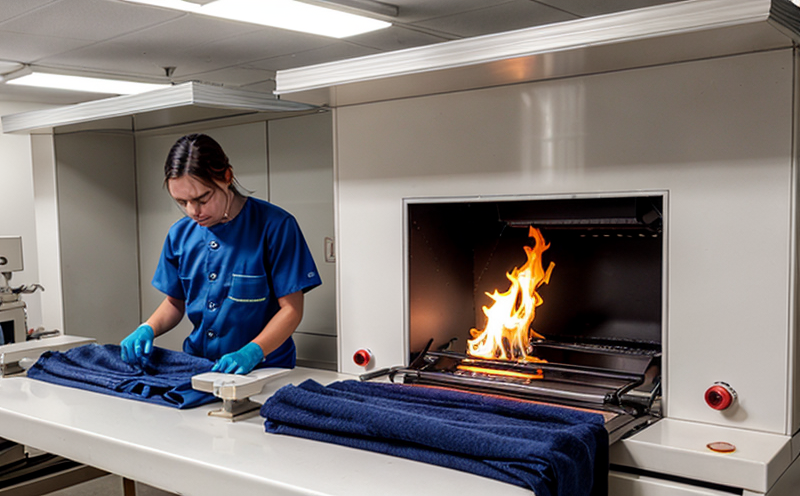Vertical Flame Spread Testing of Apparel Fabrics
The vertical flame spread testing of apparel fabrics is a critical procedure used to assess the flammability and fire resistance properties of textile materials. This test ensures compliance with international safety standards, providing manufacturers with essential data on how their products will perform in real-world conditions.
Flame spread testing is particularly important for sectors such as clothing, footwear, and home textiles where the risk of ignition can lead to severe consequences if not managed properly. The primary purpose of this test is to determine the rate at which a flame spreads across the surface of an apparel fabric sample when exposed to an open flame.
The testing process involves placing the sample on a vertical stand and exposing it to a standard heat source for a specified duration. After ignition, the time taken by the flame to spread along the length of the specimen is measured. This measurement provides valuable information about the fabric's resistance to fire spread and its potential risk in case of an accidental ignition.
The test results are crucial for manufacturers seeking to ensure their products meet stringent safety requirements set forth by regulatory bodies worldwide. By conducting this testing, companies can enhance product safety, thereby protecting consumers from hazards associated with flammable materials.
For accurate and reliable flame spread testing, it is essential to follow a standardized method. This ensures consistency in results across different laboratories and locations, which is vital for maintaining credibility and trust in the industry.
The following sections will delve deeper into the scope and methodology of vertical flame spread testing, discuss Eurolab's advantages, highlight our competitive edge, and address frequently asked questions from potential clients.
Scope and Methodology
| Aspect | Description |
|---|---|
| Test Specimen | The fabric to be tested should be cut into a specific size (typically 10 cm wide by 30 cm long) and prepared according to the relevant standards. |
| Heat Source | A standard heat source, such as a burner or an electric igniter, is used to ignite the fabric sample. The temperature of the flame should be controlled within a specified range. |
| Test Stand | The specimen is placed vertically on a test stand with a support frame that holds it in place during testing. |
| Data Collection | Timers and sensors are used to record the time taken for the flame to spread along the fabric sample. Other parameters, such as peak heat release rate (PHRR) and smoke production, may also be measured. |
| Aspect | Description |
|---|---|
| Test Environment | The testing area should be a controlled environment with specific temperature, humidity, and air flow parameters to ensure consistent test results. |
| Standardization | All tests are conducted in accordance with international standards such as ISO 13565-1 and ASTM D6473. This ensures that the testing process is standardized across different laboratories. |
| Data Analysis | The collected data is analyzed using statistical methods to determine compliance with specified safety criteria. |
| Reporting | A detailed report is generated, providing comprehensive information on the test results and recommendations for improving product safety. |
Eurolab Advantages
At Eurolab, we pride ourselves on offering superior quality testing services that meet the highest industry standards. Our expertise in fire safety testing is unmatched, ensuring accurate and reliable results every time.
- Accreditation: We are fully accredited by leading accreditation bodies such as ISO/IEC 17025 to provide credible test results.
- Experience: Our team of experienced engineers and scientists brings extensive knowledge and expertise in fire safety testing.
- State-of-the-Art Facilities: Equipped with the latest technology and equipment, our laboratories offer precise and efficient testing services.
- Comprehensive Reporting: We provide detailed reports that not only state the results but also offer valuable insights and recommendations for improvement.
Our commitment to excellence has earned us a reputation as a trusted partner in the industry. Whether you are a manufacturer, supplier, or distributor, Eurolab can help ensure your products meet the strictest fire safety standards.
Competitive Advantage and Market Impact
- Comprehensive Testing Capabilities: We offer a wide range of fire safety tests for textiles, including flame spread testing, smoke density testing, and heat release rate testing.
- Global Recognition: Our services are recognized worldwide, ensuring that our clients receive consistent results regardless of their location.
- Industry Leadership: Eurolab sets the benchmark in fire safety testing, influencing industry standards and practices.
- Cost-Effective Solutions: By offering efficient and accurate testing services, we help our clients reduce costs associated with non-compliant products.
Our competitive edge lies not only in our technical expertise but also in our commitment to customer satisfaction. We work closely with our clients to understand their specific needs and provide tailored solutions that meet their requirements.





